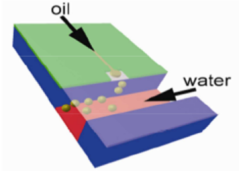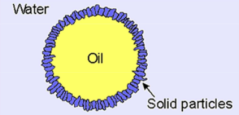Project
Formation of food-compatible Pickering emulsions using EDGE microfluidic devices
Context: EDGE microfluidic devices (Fig. 1) have been employed in our group to produce monodisperse emulsion droplets in the low micrometre range. The principle used here is the spontaneous droplet formation through Laplace pressure difference, making it a promising candidate for further upscaling and industrial usage. Until now, only surfactants and proteins have been used as emulsifiers in this set-up. However, we believe that using particles (i.e., Pickering stabilisers; Fig. 2) instead of these conventional emulsifiers could strongly improve the functioning and stability of emulsion formation within EDGE devices. This is supported by some of our recent experiments, which have shown a large increase in droplet production when inorganic (non-food grade) particles are used for droplet stabilisation (Fig. 3). It would be therefore of great interest to investigate whether such a beneficial effect can also be found when biobased particles are used to stabilise the emulsion droplets.
Objective and approach: In this context, the aim of the present thesis will be to investigate the potential of food-compatible particles to act as Pickering stabilisers for emulsion droplets produced in EDGE devices. A first part of the project will focus on making protein-based particles (e.g., from whey proteins or gelatin) with well-controlled physical properties (e.g., size, shape, charge). Then, the performance of these particles at stabilising emulsions will be tested in EDGE devices, and possibly in other emulsification devices readily available at FPE.
Relevance and perspectives: Performing such experiments using food-grade particles would open the road for a new range of possible applications of EDGE microfluidic devices.



BSc/MSc theses?
Minimum 4 months, starting approx. February/March 2015. Are you interested in this topic? Then do not hesitate to contact me or drop by to talk about current opportunities for your thesis!